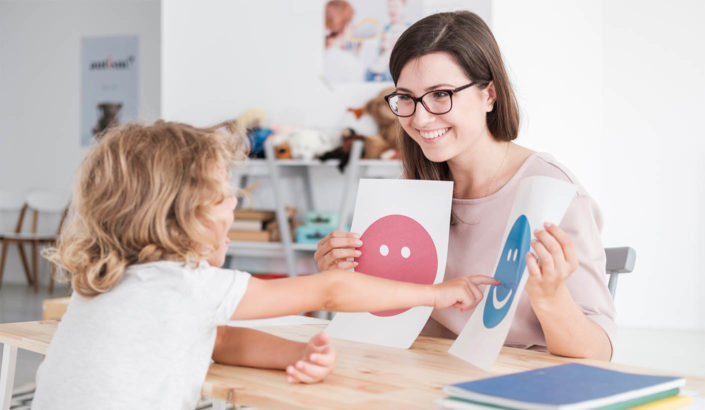
CURRICULUM ADAPTATION FOR CHILDREN WITH DISABILITIES
Dr. Nasir Sulman
Associate Professor
Department of Special Education , University of Karachi

The term ‘curriculum’ may be seen as a blanket term that encompasses everything that influences learning, from the educators, learning programmes, the medium of instruction and materials, to the hidden curriculum that incorporates values on learning. In an inclusive education system, the curriculum can respond only to the needs of all the learners through flexible approaches and accessible content.
Any society requires its members to have certain abilities and skills to be employed as they interact and participate on a societal level. These abilities and skills relate to mental capabilities and emotional stability that enable individuals to make informed decisions, both on a social and a professional level. The curriculum design, therefore, needs to incorporate learning outcomes that address these abilities and skills through exposure to appropriate learning experiences.
Although guided by societal needs, curriculum development should not be prescriptive as schools differ in context and learning needs and therefore need the scope to develop a curriculum that meets the needs of its learners and community.
In order for the curriculum to provide learners with these skills, some important values needed to include:
- Outcomes-based education as an activity-based and developmental process encompassing what learners learn and are able to do at the end of the learning process.
- Social and environmental justice, human rights and inclusivity.
- A high level of skills and knowledge for all.
- A balance of integration and progression in what is expected at each level.
- Clarity and accessibility
Adapting the curriculum
All aspects of the curriculum, as mentioned earlier, need to be developed to ensure that the diverse needs of learners are addressed. While some of this can be done at national and provincial levels (macro levels) through legislation, educators at schools, in collaboration with parents (meso level) need to take this further on a practical level to ensure that the needs of specific learners are met.
Despite many educators’ reservations regarding curriculum adaptation, majority agree that it is nothing more than ‘good teaching’, thereby implying that strategies that work for learners without barriers to learning will similarly work for learners with disabilities. Good teaching then means that learner; including learners with disabilities are supported in formulating realistic appraisals of themselves that facilitate the process of setting realistic life goals. The easiest and most effective way of ensuring this is to view all the learners in a given class as lying on a continuum of learning. On the extreme left may be learners experiencing greater learning difficulties, while others are on the extreme right and needing extensive enrichment and challenges, with a large number of learners lying between these two ends. In this way, no qualitative distinction is made between learners with disabilities and other learners.
Essentially, curriculum adaptation is therefore about recognizing individual learners’ learning style and finding ways to employ this style most effectively in the learning situation. It must provide the setting and climate in which learners can grow and develop their capacity, and criteria for selecting curricular content should be based on an understanding of the learners’ disability and needs. This simply means that the greater the learner’s learning difficulties, the more the educator would need to act as a mediator between the learner, the learning environment and the learning content.
Rationale for curriculum adaptation
When deciding on whether to adapt the curriculum or to what degree it should be adapted for the learner with disabilities, the following factors should be considered:
- Can the learner participate?
- Just like his peers?
- With environmental adaptations?
- With adapted methodology?
- With adapted teaching and learning support materials?
- With adapted expectations?
- With different goals?
If the answer to these questions is negative, the educator may feel that an Individual Education Plan (IEP) is justified. The primary goal of the Individual Education Plan (IEP) is to ensure that learners with disabilities benefit from the same curriculum as their peers. It is, however, important to ascertain on what level the learners are functioning as this will facilitate the process of adapting the curriculum into an IEP for them.
The IEP specifically refers to a plan for the individual learning needs of learners who are identified as needing support over and above the differentiation in a typical multilevel class. It is a written working document for each learner with a barrier to learning that is developed, reviewed and revised on an ongoing basis.
The IEP includes relevant information regarding the learner’s interests, strengths and needs, as well as medical or health information. It describes the learner’s current level of achievement in each learning area and lists the expectations or goals for the learner as developed by the educator, the parents and the learners themselves. The IEP needs to be updated regularly and notes of dates, results and recommendations should be kept. For foundation phase learners, the IEP is developed by a team comprising school staff, the parents and learners where possible.
Educators need to assume a major role in curriculum adaptation, since they know more accurately than the higher educational authorities, the learners’ experiences and needs. They are in a position to decide what is locally relevant and implement the adapted curriculum themselves.

Methods for adapting the curriculum
Before adapting the curriculum for the individual learners, it is important first to decide what the class activity entails, as slight adaptations may suffice, thereby eliminating unnecessary work for the educator.
A range of methods can be used by educators to guide the process of curriculum adaptation. Lorenz (1998) contends that a model of concentric circles, otherwise referred to as “multilevel instruction” by other authors (Porter, 1997), may be a good starting point in the process of curriculum adaptation. According to this model, two or three concepts or skills to be acquired by all learners are selected for the theme. These are placed in the innermost circle. Further circles are added to the diagram describing progressively more complex concepts or skills, of which smaller percentages of the learners will be expected to achieve. The outermost circle includes those skills or concepts that would be attained only by a small percentage of learners. In this way, educators would ensure that the selected concepts or skills were covered and that the entire learner needs, from those requiring concrete exposure, to those who would benefit from challenging tasks, were met. A variety of teaching strategies may also be employed during the presentation of the lesson to ensure that all the learners have optimal opportunities to acquire the concepts or skills (Porter, 1997).
Teaching strategies that support curriculum adaptation
The classroom climate as being a crucial factor in learning achievement and refers to the atmosphere created in the classroom by the rules, both spoken and unspoken, the physical layout and the teaching approaches used.
Classroom management, which affects the classroom climate, is also central to the development of supporting all the learners and meeting their needs. Given the diversity of learner needs in a classroom in terms of learning styles and pace of learning, teaching strategies need to be flexible to ensure that each learner’s needs are met. There is a number of teaching strategies that can be utilized for different lessons.
Very often, however, educators make no attempt to modify their teaching strategies to meet the learning needs of learners with disabilities. This may result in learners becoming overly dependent on the learning assistant, should one be available for them. It may also lead to disruptive behaviour as learners are no longer being challenged within their Zone of Proximal Development (ZPD), the critical space in present understanding where, through proximal mediation, the learners can be supported to construct higher levels of understanding.
One teaching strategy that many educators have found to be effective is to simplify and modify the strategy for the class as a whole. Although learners with disability are likely to have more difficulty in processing and retaining verbal input, the inclusion of pictures and concrete objects, for example, would benefit other learners as well. Presenting instructions to learners with disabilities in short blocks, rather than chunks, would avoid input overload for many learners as well. For learners who work very slowly, as is usually found in learners with disabilities or learners with low muscle tone, instruction cards may be given to the learners on completion of prior instructions. In so doing, the learners who work at a faster pace are not held back.
Adapting the actual content of the curriculum very often eliminates the need for further adaptation. It involves varying the complexity and nature of the content presented and in so doing adjusts the cognitive demand on learners, while not decreasing the value of the content. Content may be adapted by using the following strategies:
- Reduce the amount of work to be covered by summarizing it or getting learners to memorize fewer facts.
- Allow learners to complete alternate questions or problems of the activity.
- Allow learners to choose the method of presentation for their activity, a model instead of a drawing, for example.
Teaching and learning materials are used to enhance the content of what is presented and should reinforce the understanding thereof. It is not essential that all learners achieve the selected outcomes in the same manner. This means that for an activity requiring a number of questions to be answered, learners with disabilities may for example, ring or underline answers rather than write them out, or record their answers on tape recorders. Adapting materials may involve providing additional or different material. Most material may be adapted in one of four ways. Firstly, the readability level is adjusted. Secondly, the critical features of the content are enhanced. Thirdly, materials are adapted to appeal to the sensory modalities other than visual and auditory. Lastly, alternate materials are used.

A number of practical strategies, which are effective for all learners, not only those with disabilities, can be used as a technical, rather than content form of curriculum adaptation. Together with the learner’s parents, teachers planned what activities s/he would be involved in, but incorporated enough flexibility to modify activities daily if necessary. Allowing child to work in a quiet, familiar area seemed to work best as s/he responded well to a calm, disciplined situation. This gave him/her the opportunity to develop independence, while the teacher supported other learners in the class, thereby preventing him/her from being perceived as the only one to receive individual attention.
Bird’s (2004) research findings found that having clear classroom rules that are revised regularly help learners with disabilities to monitor what is acceptable behaviour. This also enables educators to monitor behaviour and identify problematic behaviour, which may be indicative of emotional factors, rather than a contravention of classroom rules. She also found that having the learners with disabilities work in short periods of time prevents loss of concentration and disruptive behaviour. Alternating work requiring concentration with work of a less demanding nature also seemed to help motivate them to focus on the more demanding tasks.
Although curriculum adaptation per se cannot happen at home, what transpires at school can be reinforced at home. Many of the values brought into the school system are learned at home and predict the learners’ attitude towards learning. It is, therefore, important for parents to create a home environment that is supportive of learning both formally and informally. Communication and collaboration between educators and parents therefore needs to happen continually as they support each other in making decisions regarding the learner and reinforcing the skills, knowledge, values and attitudes being instilled both at home and at school.
